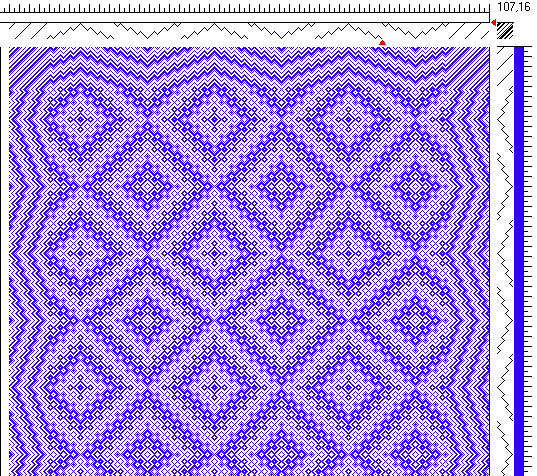Yesterday I shared this draft online, referring to it as 'simple'. Several people commented that it didn't look 'simple' (I paraphrase).
But here's the thing. You can make something 'simple' look 'fancy' - if you have enough shafts, and understand how the weave structure(s) work.
If you look closely at the threading, you can see that the progression is a V and an inverted V - with 'bumps'.
The straight line up and down the shafts advances with reverses - point progressions within the larger point of shaft 1-16-1 then flipped over 16-1-16. No further modification was done to make something truly 'fancy'.
The motif is just 67 ends, flipped to create the opposite version for another 67 ends, and those two repeat across the width of the cloth with some straight draw at the borders to make up the rest of the width of the cloth, providing 'borders' at the selvedge. The towel will be woven with a hem area of straight progression treadling to mirror the threading.
The tie-up is also 'simple' - a twill consisting of 1:3:1:3:2:2:3:1 and then doing the thing that twill does - move over and up by one step. The treadling for the towel body is 'woven as drawn in' (or woven in the same progression as the threading).
I did almost no thinking for this draft (unlike the matrix series which required megawatts of thinking!), just following the twill lines and let them resolve in the simplest way possible.
The cloth is not 'balanced' insofar as you will see more warp on one side of the cloth and more weft on the other. When I do this, I weave it with the weft side up so that I lift the fewest number of shafts. The other side of the cloth will look like this:
In this particular cloth, there won't be a dramatic difference - the warp is a combination of various shades of very pale blue/grey/slightly darker blue, and the weft will be white.
This is my first 2/8 cotton warp in well over a year - maybe two! And I'd forgotten how much faster working with a 'fatter' yarn goes.
Yesterday I beamed the warp (about 24 yards) then started threading and managed to nearly finish threading before I ran out of steam. Just 5" left to do (about 100 threads)
It has been a nice reprieve before I go back to 2/16 cotton and that very fine linen. For that I will be playing with more 'fancy' twills again. The linen is thinner than the 2/16 and I'm going to stick with 36 epi, which means the tie up will have plain weave in it to help stabilize the cloth.
The beginning of this warp will be woven for samples - in plain weave - so I needed a draft that would produce a plain weave cloth. Whatever is left over will get woven in this design using that mystery yarn I posted about a while ago. Given the mystery yarn is slightly thicker than 2/8 cotton, and stiffer, giving the cloth a hard press during wet finishing will be critical. The towels will be thicker than what I would call 'tea towel' quality, but they will still dry hands - and even pots - not so much smaller items like glasses.
I may need to put another 2/8 cotton warp into the loom to weave the rest of the samples for the second article I'm working on, but I have enough yarn to do that without needing to order more in. I will make up my mind once I'm done researching article 1 and can then give my full attention to article 2. But I have an Oct. 1, 2024 deadline, so I need to get going on this part - the part that takes the most time - the research part (or in the modern parlance, the FAFO part).
I'm looking forward to faffing around and finding out what happens when I do this, then that, then think about my results. Then moving to the next step. The actual writing will take a lot less time than the thinking about and then doing the FAFO part.





No comments:
Post a Comment